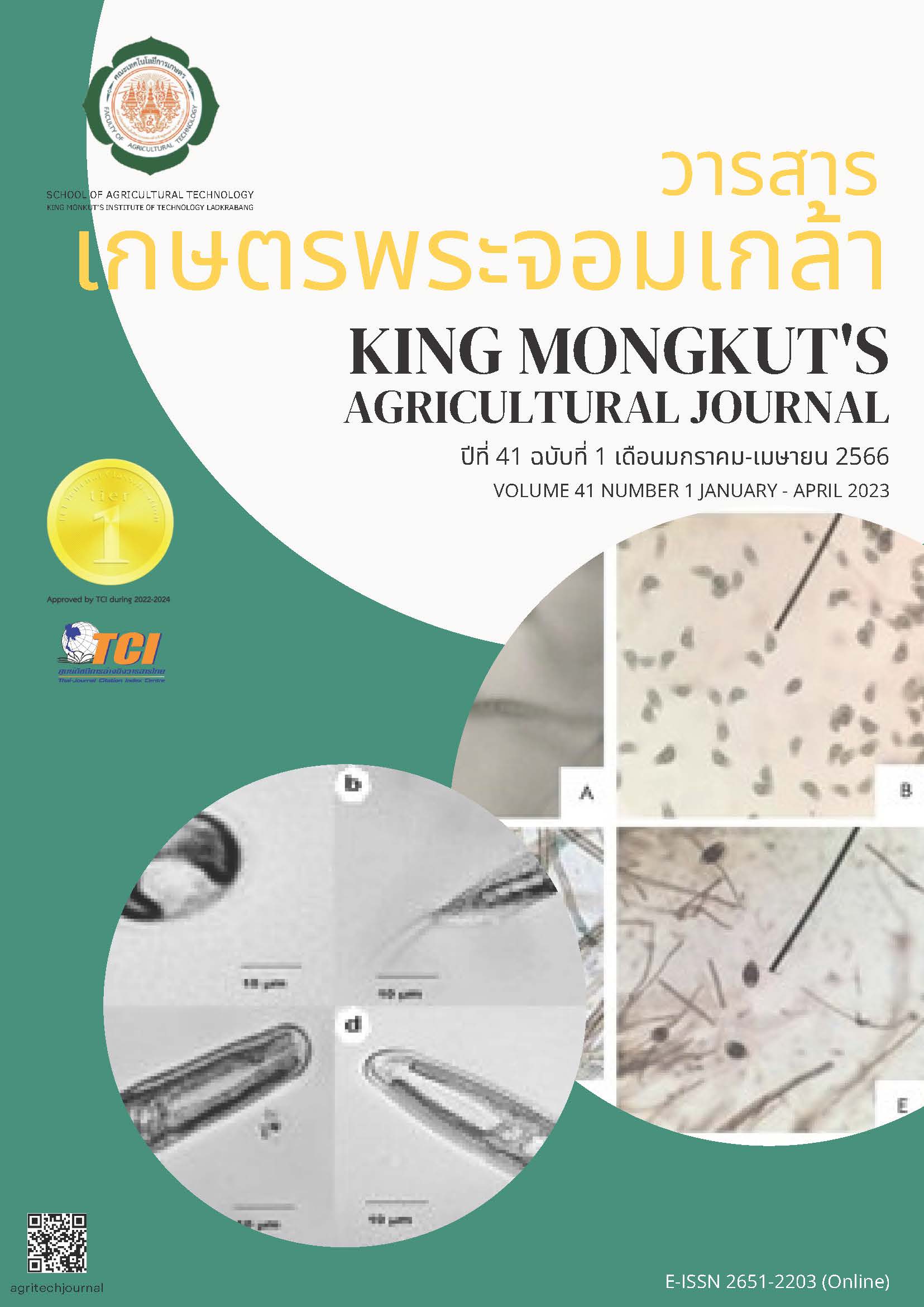Effects of 6-Benzyladenine with Silver Thiosulfate on Growth Traits and Flowering Induction in Cassava
Main Article Content
Abstract
Cassava flowering characteristics are important for breeding program in order to operate the preferred crossing along with the plan. Therefore, this research aims to assess cassava response to growth and flowering traits when it was induced by spraying 6-benzyladenine (BA) at different concentrations along with silver thiosulfate (STS). The Randomized Complete Block Design (RCBD) with four replications was planned by using Huay-bong 80 as a commercial variety that was sprayed with BA at concentrations of 0, 0.5, 1.0 1.5 and 2.0 mM with 2.0 mM STS concentrations. The data from growth traits which consisted of the plant height, the 1st branching height, and the 1st branching ratio to plant height were recorded after planting for 2-8 months. The data from flowering traits which consisted of the number of female flowers, the number of male flowers and the number of bunches per plant were recorded after planting for 5-8 months. The results showed that BA at different concentrations did not affect the growth traits of Huay-bong 80. There was no statistically significant difference in all traits of every month studied. For the flowering traits of Huay-bong 80, BA at different concentrations led to the statistically significant differences (P<0.01) in the number of female flowers, the number of male flowers and the number of bunches per plant. When the cassava was 7 months old after planting as well as the number of male flowers and the number of bunches per plant. Spraying 1.0 millimolar BA in combination with STS resulted in the greatest effect. Although the concentration of BA resulted in statistically significant difference in the flowering traits of cassava in some months studied, it did not affect the number of flowers sufficient for using in the cassava breeding program.
Article Details

This work is licensed under a Creative Commons Attribution-NonCommercial-NoDerivatives 4.0 International License.
King Mongkut's Agricultural Journal
References
Bernier, G., Kinit J., & Sachs, R. (1985). The Physiology of Flowering (Vol. 2nd). Transition to Reproductive Growth. Florida: CRC Press.
Department of Agriculture. (1983). Academic Papers volume 7th Cassava. Department of agriculture. Retrieved from: http://lib.doa.go.th/multim/e-book/EB00559.pdf
Ma, N., Tan, H., Liu, X., Xue, J., Li, Y., & Gao, J. (2006). Transcriptional regulation of ethylene receptor and CTR genes involved in ethylene-induced flower opening in cut rose (Rosa hybrida) cv. Samantha. Journal of Experimental Botany. 57(11), 2763-2773.
Oluwasanya, D., Esan, O., Hyde, P., Kulakow, P., & Setter, T. (2021). Flower development in cassava is feminized by cytokinin, while proliferation is stimulated by anti-ethylene and pruning: transcriptome responses. Journal Frontiers in plant science. 12(1), 1-17.
Office of Agricultural Economics. (2020). Agricultural Statistics of Thailand Year 2020. Retrieved from: http://impexp.oae.go.th/workflow/export_report.php.
Prangkratok, T., Phumicha, C., Wannarat, W., & Kongsil, P. (2021). Effects of Red Light and 6-Benzyladenine on Branching and Flowering in Cassava. Thai Journal of Science and Technology. 10(3), 276-286.
Srikanth, A., Schmid, M. & sciences, M. (2011). Regulation of flowering time: all roads lead to Rome. Journal Cellular and Molecular Life Sciences. 68(12), 2013-2037.
Tongumpai, P. (1986). Plant Hormones and Synthetic Substances Guidelines for utilization in Thailand. Bangkok: Dynamic publishing.
Vichukit, V., Rojanaritphichet, J., Sarobol., E., Jeamjamnanja, J., Changlek, P., Sriroth, K., & Piyajomkwan, K. (1999). New varieties of cassava Huay-Bong 80. Retrieved from: http://www3.rdi.ku.ac.th/exhibition/53/group06/vicharn/index_04.html


